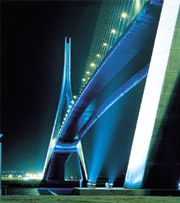The government’s long awaited changes to Part L of the Building Regulations set more onerous limits on the energy efficiency of lighting in domestic and non-domestic buildings. Just what’s involved is explained by Hugh King of Thorn Lighting:

Part L is the section of the Building Regulations dealing with conservation of heat and power from new and existing buildings, both domestic and commercial. It has been updated as the UK Government has a legal commitment to implement the European Directive on Energy Performance in Buildings (EPBD), which requires all new and existing buildings to be given an energy rating, and for new buildings to meet a minimum standard of energy efficiency.
The revisions to Part L, which came into force in April 2006, set maximum CO2 emissions for whole buildings. The changes have been designed to allow designers to choose practical and cost-effective solutions that best meet their needs. The sections on lighting have been revised, so let’s attempt to explain succinctly just what will be required. Firstly, Part L splits into two Approved documents: L1A and L1B covering new and existing dwellings and L2A and L2B for new and existing non-domestic dwellings.
Dwellings - L1A & B:
Beginning with dwellings, there are few surprises and the targets can easily be achieved using modern equipment. The efficacy target of greater than 40 lumens per circuit-watt remains. However, guidance is given on determining the number of lighting points by the sq m of dwelling floor area, rather than by the number of rooms. One energy efficient fitting per 25m sq and one per four fixed light fittings is now required. For external lighting maximum wattage is 150W with automatic switching off - with photocell, PIR and time switch - or light fittings with sockets for lamps with over 40 lumens per watt i.e. no GLS or halogen.
Non Dwelling Buildings - L2A:
For new buildings other than dwellings (Offices, Industrial and Storage areas) the revised Part L requires an improved average efficiency for the whole building of not less than 45 luminaire lumens/circuit watt (up from 40). This is actually a big change because previously most lighters took a short cut - by employing fittings from a given list of high efficiacy lamps they knew they wouldn’t fall foul of the requirements. Now they have to compute the figures and furthermore there is no waiver for the first 500W of installed lighting load.
For lighting serving buildings other than offices, industrial and storage premises the average initial (100h) lamp circuit efficacy remains at not less than 50 lumens/circuit watt.
Lighting controls are required for general lighting in all types of space, with manual local switches now called for within 6m of the fitting or twice the height of the luminaire above the floor. Where a space is served by side windows and daylight Part L asks for the outer row of fittings to be separately switched. Note that no easement is now given for using lighting controls because the calculation tool used to determine the overall BER (Building carbon dioxide Emission Rate) accounts for their impact. Modification is though allowed in L2B, but more of that later.
Display lighting undergoes a slight change. Whilst the initial efficacy target of not less than 15 lumens per circuit watt is retained lighting controls are now introduced. A way of meeting the requirement would be to connect the display lighting in dedicated circuits that can be switched off when not required – using time switches. Finally emergency lighting is excluded.
Outside of document L2A, but still within Part L, are overall performance standards for the building. For lighting, installed power density targets are given: in offices, industrial and storage spaces, divide the illuminance for the area by 100, then multiply by 3.75 W/m²/100 lux; for other spaces divide by 100 and multiply by 5.2 W/m²/100 lux. However, these shouldn’t be too difficult to meet with existing best practice.
Work in existing Non Dwelling Buildings – L2B:
The new requirement is that when existing buildings with a floor area over 100m sq undergo major renovation (consequential improvements, an extension, material change of use or material alteration) their energy efficiency should be upgraded. In lighting terms any general lighting system with an average lamp efficiency of less than 40 lamp- lumens/circuit watt should be upgraded by either a new luminaire or with improved lighting controls. Otherwise the requirement as for L2A are followed, with the notable exception of lighting controls where, as previously, luminaire control factors can be applied to the overall efficacy rating when an effective lighting control system is installed. However, these factors have been strengthened i.e. 0.9 instead of 0.8 for photocells and PIRs and 0.85 against 0.75 for the use of both together. Furthermore, a report from a competent person stating that the control system has been properly commissioned is a necessity.
Concluding thoughts:
The lighting requirements of ADL1 and 2 are, quite rightly in this time of climate change, more stringent than those of the outgoing Part L. However, please note that lighting is not just about energy saving. With good lighting design you can save energy and be conducive for the occupants to perform efficiently and in comfort. People function better and more happily if the lighting is right. Lighting is, after all, for people and places.
